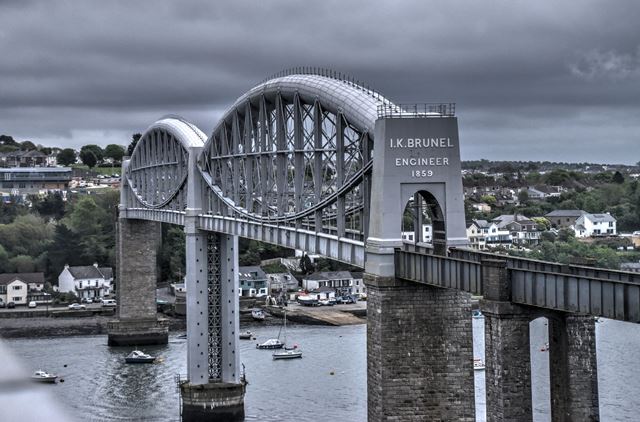We Recommend:
Bach Steel - Experts at historic truss bridge restoration.
Royal Albert Bridge

Primary Photographer(s): Nathan Holth
Bridge Documented: May 10, 2018
Saltash and Plymouth: South West, England: United Kingdom
Metal 12 Panel Multiple-Type-Connected Lenticular Through Truss, Fixed and Approach Spans: Metal Deck Girder, Fixed
1859 By Builder/Contractor: Charles John Mare and Hudson and Male and Engineer/Design: Isambard Kingdom Brunel
2014
455.0 Feet (138.7 Meters)
2,187.5 Feet (666.8 Meters)
16.8 Feet (5.12 Meters)
2 Main Span(s) and 17 Approach Span(s)
Not Applicable

View Information About HSR Ratings
Bridge Documentation
The Royal Albert Bridge is one of the most impressive bridges in the UK and indeed the world. Built in 1859, this bridge's 455 truss spans represented an unimaginable span length for metal truss bridges at the time. Even more impressive, these spans were assembled along the nearby shore, floated into position and slowly lifted into their place high above the river (100 feet of navigation clearance) as the end piers were constructed. Even today in bridge construction, moving a pre-fabricated span of 455 feet would be worthy of a news article. Imagine what an impressive feat this would have been in 1859.
This unique bridge was one of the crowning achievements of famous engineer Isambard Kingdom Brunel. He died shortly after the bridge was completed, and the bridge had his name added to the portals in honor of him. Brunel's design here resulted in one of the first lenticular truss bridges in the world, using a unique massive tubular top chord.
This bridge remains in good condition today and continues to serve rail traffic. It was rehabilitated in 2010-2014. The historic integrity of the two main spans is good, although some alterations have taken place care has been made to preserve and not alter the original design details created by Brunel. An exception is the approach spans of the bridge. The original Brunel designed plate girder approach spans (which were similar to the deck-level girders that remain on the main truss spans) were replaced ca. 1905 with standard looking riveted plate girders.

Above: This historical image shows the assembly of one of the truss spans along the river.
Above: This photo shows the second truss span being slowly lifted into place as the far pier was constructed.
Above: This historical photo shows the original approach plate girder spans.
Official Heritage Listing Information and FindingsListed At: Grade I Discussion: List Entry Number: 1159292 |
![]()
Photo Galleries and Videos: Royal Albert Bridge
Structure Overview
Original / Full Size PhotosA collection of overview photos that show the bridge as a whole and general areas of the bridge. This gallery offers photos in the highest available resolution and file size in a touch-friendly popup viewer.
Alternatively, Browse Without Using Viewer
![]()
Structure Details
Original / Full Size PhotosA collection of detail photos that document the parts, construction, and condition of the bridge. This gallery offers photos in the highest available resolution and file size in a touch-friendly popup viewer.
Alternatively, Browse Without Using Viewer
![]()
Structure Overview
Mobile Optimized PhotosA collection of overview photos that show the bridge as a whole and general areas of the bridge. This gallery features data-friendly, fast-loading photos in a touch-friendly popup viewer.
Alternatively, Browse Without Using Viewer
![]()
Structure Details
Mobile Optimized PhotosA collection of detail photos that document the parts, construction, and condition of the bridge. This gallery features data-friendly, fast-loading photos in a touch-friendly popup viewer.
Alternatively, Browse Without Using Viewer
![]()
Maps and Links: Royal Albert Bridge
Coordinates (Latitude, Longitude):
Search For Additional Bridge Listings:
Additional Maps:
Google Streetview (If Available)
GeoHack (Additional Links and Coordinates)
Apple Maps (Via DuckDuckGo Search)
Apple Maps (Apple devices only)
Android: Open Location In Your Map or GPS App
Flickr Gallery (Find Nearby Photos)
Wikimedia Commons (Find Nearby Photos)
Directions Via Sygic For Android
Directions Via Sygic For iOS and Android Dolphin Browser
Ordnance Survey Maps (UK Only)






